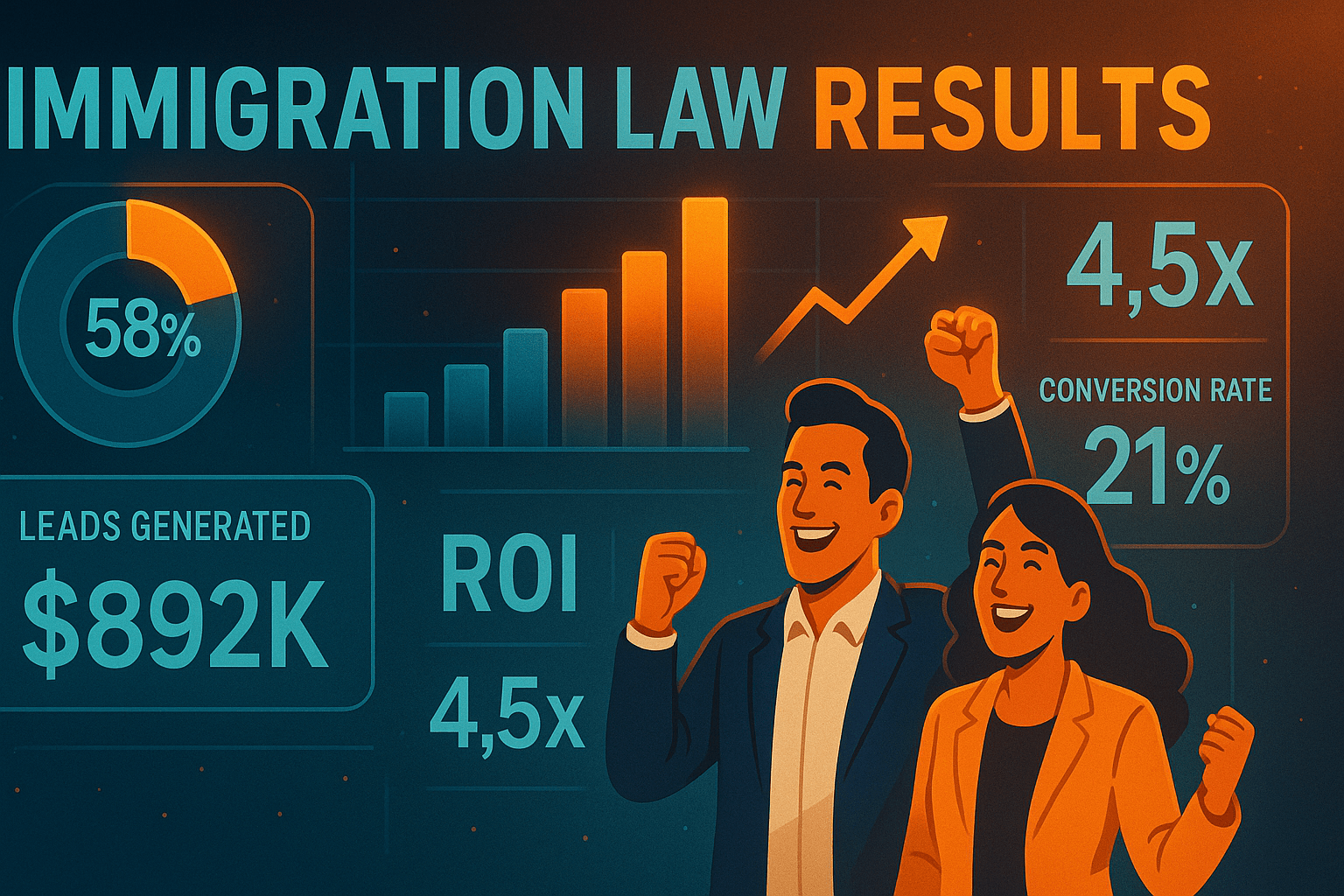Advanced Paid Ads Management for Immigration Law Firms: A Complete Guide to ROI-Driven Campaigns
by Design Delulu Editorial · October 28, 2025

Smart, fast, and measurable. Here's how paid ads management helps Immigration Law win.
Immigration law is one of the most competitive and time-sensitive practice areas in digital advertising. When someone searches for visa assistance, deportation defense, or family-based immigration help, they need answers immediately—and they're likely comparing multiple firms within minutes. This makes paid advertising the fastest path to visibility, but only when campaigns are structured, targeted, and optimized with precision.
Generic PPC strategies don't work in immigration law. The stakes are too high, the competition too fierce, and the client journey too complex. Successful paid ads management requires deep industry knowledge, sophisticated audience segmentation, creative testing frameworks, and relentless data-driven optimization. This guide reveals how advanced paid ads management transforms immigration law firms from invisible to indispensable—delivering qualified leads, maximizing return on ad spend, and building sustainable growth engines that compound over time.

Why Immigration Law Firms Need Specialized Paid Ads Management
Immigration law advertising isn't like promoting e-commerce products or local services. The decision-making process involves high emotional stakes, complex legal requirements, and significant financial commitment. Prospective clients are often navigating life-changing situations—obtaining work visas, reuniting families, fighting deportation, or pursuing citizenship. They need immediate reassurance that they've found the right attorney.
Standard PPC approaches fail because they treat all legal services the same. Immigration law demands unique considerations:
- Multi-language targeting: Campaigns must reach Spanish, Mandarin, Hindi, and other language speakers with culturally appropriate messaging
- Geographic precision: Immigration services vary dramatically by location, requiring hyper-local targeting combined with national visibility
- Service complexity: From H-1B visas to asylum cases, each practice area attracts different search intent and requires distinct campaign structures
- Compliance sensitivity: Ad copy must navigate strict legal advertising rules while remaining compelling and conversion-focused
- Extended consideration cycles: Prospects research extensively before booking consultations, demanding sophisticated retargeting and nurture sequences
Specialized paid ads management addresses these challenges through industry-specific frameworks, proven testing methodologies, and optimization systems built specifically for immigration law. The result is higher-quality leads at lower acquisition costs, with measurable impact on firm revenue.
The Strategic Foundation: Account Architecture That Scales
Campaign structure determines everything. A poorly organized account wastes budget on irrelevant clicks, makes optimization impossible, and obscures performance insights. Advanced account architecture for immigration law starts with service-specific campaign separation, audience segmentation by buyer stage, and granular ad group organization that enables surgical budget allocation.
Service-Based Campaign Structure
Each immigration service requires dedicated campaigns with tailored messaging, landing pages, and bidding strategies:
- Employment-based immigration: H-1B, L-1, PERM labor certification, EB-5 investor visas
- Family-based immigration: Marriage-based green cards, K-1 fiancé visas, family reunification
- Deportation defense: Removal proceedings, asylum applications, cancellation of removal
- Citizenship & naturalization: N-400 applications, citizenship test preparation
- Emergency services: ICE detention bonds, expedited processing, humanitarian parole
This separation allows precise budget pacing based on service profitability, seasonal demand patterns, and case capacity. High-margin services receive aggressive bidding, while capacity-constrained practice areas scale strategically.
Full-Funnel Audience Segmentation
Immigration prospects move through distinct awareness stages requiring different messaging approaches:
- Awareness stage: Educational content addressing immigration pathways, eligibility requirements, timeline expectations
- Consideration stage: Firm differentiation, attorney credentials, success stories, transparent pricing
- Decision stage: Consultation booking, urgency reinforcement, competitive comparison, trust signals
- Retention stage: Additional services, referral programs, case status updates
Each stage receives customized ad creative, landing page experiences, and conversion goals aligned to prospect readiness.
Negative Keyword Strategy
Immigration law attracts massive irrelevant traffic from people seeking general information, DIY solutions, or non-legal immigration services. Comprehensive negative keyword lists protect budget by excluding:
- Informational queries ("how to," "requirements for," "process of")
- Free service seekers ("free immigration lawyer," "pro bono immigration help")
- DIY filers ("fill out N-400 myself," "immigration forms download")
- Non-legal services ("immigration medical exam," "passport photos," "translation services")
- Job seekers ("immigration lawyer jobs," "work as immigration attorney")
Negative lists require continuous refinement based on search query reports, preventing wasted spend and improving overall account quality scores.

Creative Testing Framework: Finding What Converts
Creative is the frontline of campaign performance. Even perfect targeting fails without compelling ad copy and visual assets that stop scrolling and drive action. Systematic creative testing identifies high-performing angles, messaging frameworks, and design elements that resonate with immigration prospects.
Hook Variation Testing
The first three seconds determine whether prospects engage or scroll past. Test multiple hook categories simultaneously:
- Outcome-focused: "Successfully Filed 2,847 H-1B Petitions" or "94% Green Card Approval Rate"
- Pain-point addressing: "Visa Denied? We Fight Back" or "Facing Deportation? Get Immediate Help"
- Question-based: "Is Your Visa Application at Risk?" or "Eligible for Citizenship? Find Out Now"
- Authority-positioning: "Former USCIS Attorney Now Helping Families" or "25 Years Immigration Law Experience"
- Urgency-driven: "Processing Times Just Changed—Act Now" or "Limited Consultation Slots This Week"
Run structured A/B tests across platforms, measuring click-through rates, conversion rates, and cost per qualified lead. Winners graduate to expanded budget allocation while underperformers cycle out.
Angle Diversification
Different prospects respond to different value propositions. Test multiple positioning angles:
- Speed & efficiency: Faster processing, expedited filing, quick response times
- Success rate proof: Case approvals, client testimonials, before/after stories
- Specialization depth: Niche expertise in specific visa types or case complexities
- Transparent pricing: Flat fees, payment plans, no hidden costs
- Accessibility: Multilingual services, evening hours, virtual consultations
Track which angles perform best for each service line and audience segment, building a creative playbook that compounds effectiveness over time.
Visual Asset Strategy
Immigration law creative benefits from authentic visuals over stock imagery. Test:
- Attorney photos: Professional headshots establish credibility and human connection
- Client success moments: Naturalization ceremonies, visa approvals, family reunions (with permission)
- Process visualizations: Timeline graphics, step-by-step flowcharts, checklist infographics
- Trust indicators: Award badges, rating screenshots, attorney licensing credentials
- Video testimonials: Real clients sharing experiences (most powerful but resource-intensive)
Match visual style to platform norms—polished professional imagery for Google Search, authentic social-first content for Facebook and Instagram, authoritative text-heavy designs for LinkedIn.
Audience Strategy: Reaching the Right People at the Right Time
Immigration law audiences segment across multiple dimensions—nationality, visa type, urgency level, geographic location, and digital behavior. High-signal audience targeting combines platform-native segments with custom-built audiences that reflect actual client profiles.
Search Intent Mapping
Search queries reveal buyer stage and service need. Structure keyword groups by intent level:
- High-intent commercial: "immigration attorney near me," "hire deportation lawyer," "green card lawyer consultation"
- Service-specific research: "H-1B visa lawyer," "marriage green card attorney," "asylum application help"
- Comparison shopping: "best immigration lawyer," "immigration attorney reviews," "immigration law firm cost"
- Problem-aware: "visa denied what to do," "deportation defense options," "how to appeal USCIS decision"
High-intent keywords receive premium bids and direct-to-consultation landing pages. Research-stage queries drive to educational content with consultation CTAs. Comparison searches emphasize differentiation and social proof.
Geographic Targeting Precision
Immigration services operate in specific jurisdictions with varying case complexity and competition levels. Layer targeting strategies:
- Radius targeting: Capture "near me" searches within service areas
- Zip code exclusions: Avoid low-conversion areas based on historical data
- Metropolitan area campaigns: Separate urban and suburban strategies with appropriate budgets
- National visibility: Remote consultation services target nationwide with geographic bid adjustments
Analyze performance by region, adjusting bids to emphasize high-conversion locations while maintaining presence in emerging markets.
Custom Audience Building
Platform-specific audiences amplify targeting precision:
- Customer match lists: Upload past client emails for lookalike audience creation
- Website visitor segments: Retarget specific page visitors (visa type pages, attorney bios, blog content)
- Engagement audiences: Target users who watched videos, submitted forms, or downloaded resources
- Similar audiences: Expand reach to prospects resembling best-converting clients
Combine custom audiences with demographic and interest overlays for sophisticated micro-targeting that improves both conversion rates and return on ad spend.
Retargeting Sequences
Immigration prospects rarely convert on first visit. Multi-touch retargeting nurtures consideration:
- Day 1-3: Consultation booking reminders with urgency messaging
- Day 4-7: Educational content addressing common objections and questions
- Day 8-14: Social proof emphasis—testimonials, case results, attorney credentials
- Day 15-30: Special offers, limited-time promotions, alternative service options
- Day 31+: Seasonal messaging, policy updates, re-engagement campaigns
Frequency capping prevents ad fatigue while maintaining top-of-mind awareness throughout extended decision cycles.
Optimization Systems: Turning Data Into Growth
Launch is just the beginning. Systematic optimization compounds performance improvements through weekly testing, monthly strategic reviews, and quarterly resets that align campaigns with business priorities.
Performance Metrics That Matter
Immigration law firms should track revenue-aligned KPIs, not vanity metrics:
- Primary metrics: Cost per qualified lead, consultation booking rate, client acquisition cost, return on ad spend
- Supporting metrics: Click-through rate, conversion rate, quality score, impression share, landing page performance
- Business metrics: Lead-to-client conversion rate, average case value, client lifetime value, channel attribution
Weekly reviews identify underperforming campaigns for budget reallocation. Monthly analyses reveal creative fatigue requiring refreshed assets. Quarterly planning sessions reset priorities based on firm capacity, seasonal demand, and competitive dynamics.
Bid Strategy Evolution
Immigration law bidding requires agility based on performance data:
- Manual CPC: Launch phase with new campaigns to establish baseline performance
- Enhanced CPC: Transition to automated bid adjustments after initial learning period
- Target CPA: Implement once sufficient conversion data exists (minimum 30 conversions per month)
- Target ROAS: Advanced strategy for firms tracking client value and case profitability
- Maximize conversions: Seasonal surge campaigns during policy changes or deadline periods
Continuously test bid strategies against control campaigns, graduating to more sophisticated automation as data confidence increases.
Landing Page Optimization
Traffic quality means nothing without conversion-optimized landing pages. Test systematically:
- Headline variations: Pain-point focus vs. outcome promise vs. credibility emphasis
- Form length: Multi-step forms vs. single-page collection vs. phone-first contact
- Trust signals: Review placements, credential displays, award badges, client logos
- CTA copy: "Schedule Consultation" vs. "Get Your Free Assessment" vs. "Speak to an Attorney Now"
- Page speed: Image optimization, code minification, CDN implementation for sub-3-second loads
Implement multivariate testing for high-traffic pages, isolating which elements drive conversion lift and which create friction.
Incrementality Testing
Not all conversions are incremental—some prospects would have found you anyway. Incrementality analysis reveals true campaign contribution:
- Run geo-based holdout tests pausing ads in control markets
- Compare organic inquiry rates between test and control regions
- Measure brand search lift from paid campaigns
- Calculate true incremental ROAS accounting for baseline conversions
This prevents over-attribution to paid channels and optimizes budget allocation across the entire marketing mix.

Implementation Roadmap: From Strategy to Results
Successful paid ads programs follow structured implementation phases that minimize risk while accelerating learning.
Phase 1: Discovery & Strategic Planning (Week 1-2)
Foundation-setting determines campaign success:
- Business audit: Review service offerings, pricing, capacity constraints, ideal client profiles
- Competitive analysis: Assess competitor ad strategies, messaging angles, budget levels
- Historical data review: Analyze past campaign performance, identifying wins and failures
- Goal setting: Establish clear KPIs, budget parameters, timeline expectations
- Tracking implementation: Deploy comprehensive conversion tracking, call tracking, CRM integration
Deliverables include strategic blueprints, audience targeting specifications, creative briefs, and measurement frameworks.
Phase 2: Campaign Build & Launch (Week 3-4)
Execution with quality assurance at every step:
- Account architecture: Build campaign structure, ad groups, keyword targeting
- Creative development: Write ad copy variations, design visual assets, produce video content
- Landing page creation: Design and deploy conversion-optimized destination pages
- QA process: Test tracking pixels, verify click-through flows, confirm form submissions
- Soft launch: Begin with conservative budgets to validate setup and gather initial data
Launch checklists ensure nothing falls through cracks, preventing costly mistakes that waste early-stage budget.
Phase 3: Optimization & Scaling (Week 5-8)
Data-driven refinement accelerates performance:
- Daily monitoring: Review spend pacing, conversion flow, quality score changes
- Weekly optimization: Pause underperformers, scale winners, test new variations
- Creative refresh: Replace fatigued assets, introduce seasonal messaging, test new angles
- Audience expansion: Layer new targeting segments, expand geographic reach, test lookalike audiences
- Budget reallocation: Shift spend toward highest-performing campaigns and channels
This phase builds momentum, with compounding improvements in cost efficiency and lead quality.
Phase 4: Maturity & Continuous Improvement (Ongoing)
Sustained excellence through systematic refinement:
- Advanced automation: Implement smart bidding strategies, responsive search ads, dynamic remarketing
- Channel expansion: Test new platforms (TikTok, Reddit, podcast ads) with proven creative frameworks
- Predictive modeling: Use historical data to forecast seasonal trends and optimize budget timing
- Competitive monitoring: Track competitor changes and adapt strategies to maintain edge
- Quarterly planning: Align campaigns with business priorities, capacity changes, market conditions
Mature programs achieve stable cost-per-lead performance while continuously testing innovations that push boundaries.
Industry-Specific Considerations for Immigration Law
Immigration law presents unique challenges requiring specialized approaches that generic PPC strategies can't address.
Policy Changes & Timely Messaging
Immigration law evolves constantly with policy shifts, court decisions, and administrative changes. Agile campaign management capitalizes on these moments:
- Monitor USCIS updates, visa bulletin changes, executive actions
- Create rapid-response ad creative addressing breaking developments
- Adjust messaging when processing times change or new pathways open
- Launch surge campaigns during deadline-driven periods (H-1B cap season, DACA renewals)
Firms that move fastest capture anxious prospects seeking immediate guidance during uncertain times.
Multilingual Campaign Execution
Immigration prospects often prefer communicating in their native language. Effective multilingual advertising requires:
- Native speaker copywriting: Professional translation plus cultural adaptation, not just Google Translate
- Language-specific landing pages: Full translation including forms, CTAs, trust signals
- Localized keyword research: Search behavior varies by language and cultural background
- Bilingual call handling: Ensure staff can respond to inquiries in advertised languages
Spanish, Mandarin, Hindi, Vietnamese, and Arabic campaigns often deliver lower CPLs than English due to reduced competition.
Compliance & Ethical Advertising
Legal advertising faces strict regulatory requirements. Immigration law ads must:
- Avoid outcome guarantees or success rate claims without proper disclaimers
- Clearly identify as advertising and include attorney credentials
- Never misrepresent government affiliation or official status
- Maintain truthful, non-deceptive pricing representations
- Respect client confidentiality in testimonials and case studies
Work with legal marketing specialists who understand bar association rules and platform advertising policies to avoid account suspensions.
Long Sales Cycles & Attribution Complexity
Immigration cases involve extended research and decision-making. Prospects may engage through multiple touchpoints before converting:
- Implement multi-touch attribution models capturing full customer journey
- Use CRM integration to track leads from click through case signing
- Calculate true client acquisition cost including soft costs and time lag
- Build nurture sequences that maintain engagement during consideration periods
Last-click attribution dramatically undervalues paid ads impact—use data-driven attribution to understand true channel contribution.
Common Pitfalls & How to Avoid Them
Immigration law firms often repeat predictable mistakes that destroy campaign effectiveness:
- Broad targeting waste: Casting wide nets generates clicks but few conversions. Solution: Start narrow with high-intent keywords and proven buyer personas, expanding only after validating performance.
- Generic landing pages: Sending all traffic to the homepage kills conversion rates. Solution: Create service-specific landing pages matching ad messaging and search intent.
- Set-it-and-forget-it management: Campaigns decay without active optimization. Solution: Commit to weekly reviews, monthly testing, and continuous refinement.
- Ignoring mobile experience: Most immigration searches happen on mobile devices. Solution: Prioritize mobile-responsive designs, fast load times, and tap-friendly forms.
- Insufficient budget: Underfunding campaigns prevents reaching critical learning thresholds. Solution: Allocate minimum $3,000-$5,000 monthly per major market to generate meaningful data.
Learn from others' mistakes rather than repeating them—experienced management avoids these traps from day one.
Measuring Success: Benchmarks & Expectations
What should immigration law firms expect from paid ads management? While results vary by market, competition, and service mix, general benchmarks provide guidance:
- Click-through rate: 3-6% for search campaigns, 0.5-2% for display/social
- Conversion rate: 5-15% for optimized landing pages
- Cost per click: $8-$25 for competitive immigration keywords
- Cost per lead: $75-$300 depending on service type and market
- Lead-to-client rate: 15-40% based on follow-up process and service pricing
- Client acquisition cost: $500-$2,000 for full-service representation
- Return on ad spend: 3:1 to 8:1 for mature, optimized campaigns
Early campaigns typically underperform benchmarks during learning phases. Expect 60-90 days to establish baseline performance, with consistent improvement through month six as optimization compounds.
Conclusion: Building Your Competitive Advantage
Immigration law paid advertising separates growing firms from stagnant ones. While organic marketing builds slowly over years, paid ads deliver immediate visibility to prospects actively seeking help. The difference between amateur and advanced management is the difference between wasted budget and predictable growth.
Success requires three commitments: strategic thinking that aligns campaigns with business priorities, systematic execution that follows proven frameworks, and relentless optimization that compounds improvements over time. Firms that master these fundamentals build sustainable competitive advantages that competitors can't easily replicate.
The immigration law landscape will continue evolving with policy changes, technological advances, and shifting demographics. Your paid ads strategy must evolve with it—testing new platforms, adapting to algorithm changes, and maintaining focus on what actually drives revenue. Start with solid fundamentals, measure religiously, and optimize continuously. That's how advanced paid ads management transforms immigration law practices from struggling for visibility to dominating their markets.
Frequently Asked Questions
Let’s level up your Immigration Law business
Need services that actually move the needle for Immigration Law? See our approach, pricing, and timelines—then book a quick call.
Additional Resources
- Schedule Your Strategy Session
Get a personalized paid ads assessment for your immigration law firm. We'll audit your current approach, identify opportunities, and outline a custom roadmap to achieve your growth goals.
- View Our Immigration Law Success Stories
Explore real campaign results, case studies, and before/after transformations showing how we've helped immigration law firms scale profitably through advanced paid ads management.
- Access Free PPC Tools & Resources
Download our immigration law PPC toolkit including keyword research templates, creative testing frameworks, landing page checklists, and budget calculators to improve your campaigns immediately.
Related Reading

Discover how electricians use paid ads management to generate qualified leads, reduce cost-per-acquisition, and scale revenue. Strategy, KPIs, and proven framework inside.

Master paid ads management for jewelry stores with proven strategies for Google, Facebook & Instagram. Get higher ROAS, better targeting, and sustainable growth.
